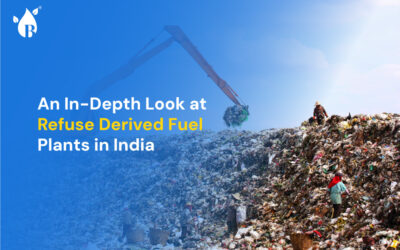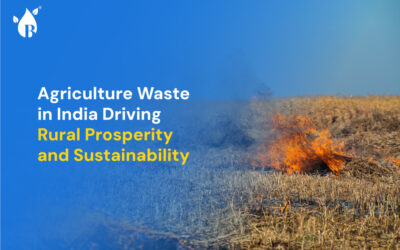
Most people are aware that the industrial age owes its success to fossil fuels as they sparked all the developments that have happened so far worldwide. Unfortunately, this enjoyment does not last long as humankind might soon run out of these fuels.
Fossil fuels are a type of fuel that was created millions of years ago by the buried remains of once-living organisms. These fossil fuels have been stored beneath the Earth for millions of years, but when we mine them and burn them, we release all that stored carbon back into our atmosphere. As a result, the combustion rate contributes to 89% of global carbon emissions and has serious environmental consequences today. As a result, climate change is chasing to harm the planet.
Owing to the depletion of fossil fuel resources in a few years, there is no doubt that the heavily fuel dependent India will become vulnerable if fuel energy security is not met. Also, global emissions of greenhouse gases (GHGs) must peak before 2025 in order to limit global warming to 1.5°C above pre-industrial levels, as specified in the Paris Agreement. In order to achieve these goals, we need to reduce GHG emissions to 43% by 2030 and net zero by 2050, as mandated by the UNFCCC. Fortunately, this goal allows several new biofuel manufacturers to establish themselves in the biofuel sector and contribute to the creation of a more sustainable environment.
Hence, without further delay, we should move forward with sustainable energy sources such as solar, hydro, and wind, along with biofuels.
A lot of hope is kept on biofuels to create a healthier planet. Are they effective, sustainable, or carbon-neutral? Several questions, criticisms, debates, and arguments arise, which are mandated to keep going.
Still, an important reason one can switch to biofuels is their carbon neutrality. When you burn fossil fuels, you release carbon into the atmosphere that has been stored there for millions of years. That’s not good for our environment.
But when you use biofuels, the carbon in them is absorbed by plants and trees that are still alive! So when they’re burned, they release back into the atmosphere only what they have stored up over their lifetime.
Now, take a moment and think about how your grandmother used to cook when they were younger. They obviously used wood and agricultural waste to generate heat for cooking. Well! The concept is similar, but the approach is different. Here, we use similar kinds of residues in different forms for industrial heating purposes to curb carbon emissions.
Biofuels are mostly made from biomass, a renewable organic material that produces sustainable energy sources like biocoal, methanol, biodiesel, and many more. As biomass is replenished easily, it is considered renewable. Its blending properties make it widely acceptable.
Solid biofuel or loose biomass products include sawdust, wood chips (wood residues that are available all year), turmeric spent, coffee husks, rice husks, and cashew shell (agricultural residues that are mostly seasonal), and briquettes and pellets (solid biomass that are compressed forms of several loose biomass products). As a matter of fact, 1 kg of biomass waste produces 650 gm of briquettes and pellets, which are primarily used in industrial boilers to generate heat. To boost these fuels, the Indian government mandated that industries use 10% co-firing of biomass instead of coal.
Since biofuel mostly relies primarily on food crops they have certain downsides such as population growth, poverty, intensive farming, deforestation, etc. However, if residue raw materials are used in a systematic manner, the biofuel purpose will be completely met.
There are several difficulties associated with the biofuel industry since it’s a new niche. Despite all that, biofuels are still at the top of the hope list as they have the ability to reduce CO2 emissions, especially in the transportation sector.
Liquid biofuels such as biodiesel, ethanol, tyre, and plastic oils are used in automobiles as well as industrial applications.
Biodiesel is a fuel that can be used to power a diesel engine. Their power factor works very well with engines that operate on regular petroleum-powered ones due to the similarity of the pure components. Biodiesel is most commonly made from Used cooking oil (UCOs). Also, it can also be made from animal fats like beef tallow and even chicken fat!
Bio-ethanol is produced from corn, sugarcane, and other crops, particularly bagasse, which is the leftover fiber extracted after crushing sugarcane into juice. In fact, one kilogramme of bagasse yields 0.2 liters of bioethanol. Nowadays, ethanol is converted into fuel in order to be used in the automotive industry. Notably, they are considered to be cost-effective, environmentally friendly, and renewable, and they greatly minimize our reliance on fossil fuels.
Tyres that are discarded after use have a fascinating life. Let’s see how it goes!
The thriving automotive industry produces 1.6 billion tyres worldwide. One billion waste tyres are produced once they are used. Due to its low recycling rate, most of the waste tyres are just left to rot in landfills. Fortunately, engineering and technology were able to generate oil out of it via a pyrolysis process. Furthermore, 1 kg of tyre waste yields 0.5 L of tyre oil, which has a high heating value of around 10,000 kcal/kg. It can be directly substituted for fuel oil in industries such as boiler heating, cement manufacturing, steel manufacturing, glass manufacturing, boilers, and so on. Moreover, tyre oil cannot directly replace diesel in internal combustion engines, but it can be blended with diesel with high heating values.
Plastic oil is another biofuel product made from PP (polypropylene), HDPE (high density polyethylene), LDPE (low density polyethylene), and MSW (municipal solid waste) wastes. RDF (refuse derived fuel) is a direct fuel used in the boilers of the cement industry.
Biofuels are promising as they have the potential to use waste products as raw materials. According to the Indian government, more than 350 million tonnes of agricultural waste alone are produced every year. If these resources are used advantageously, along with proper policy implementation and spreading awareness, then it is possible to meet the sustainability goals and energy security goals of India as well as the world.



